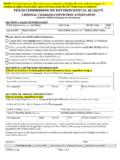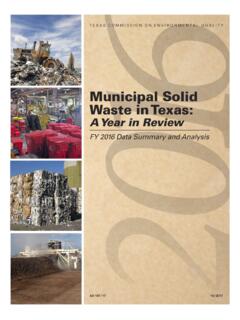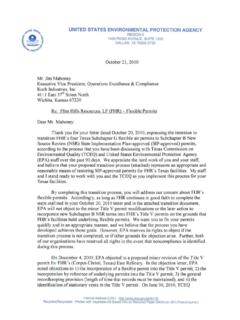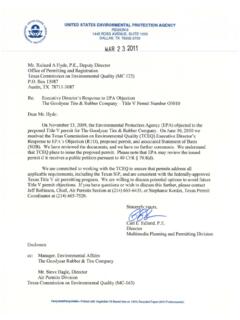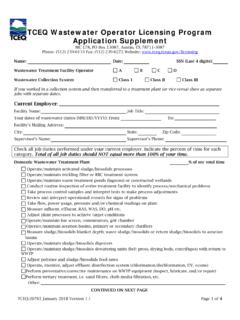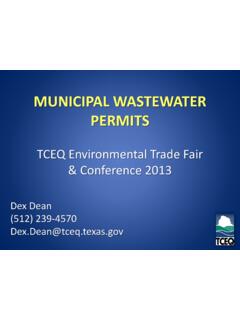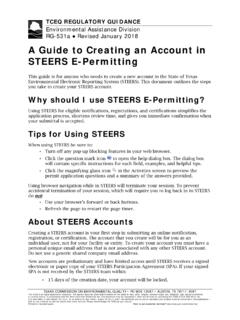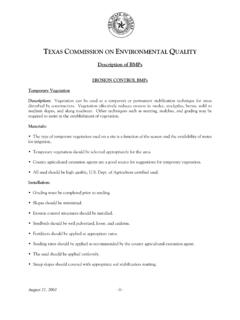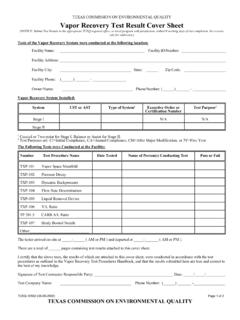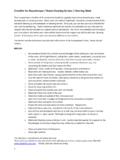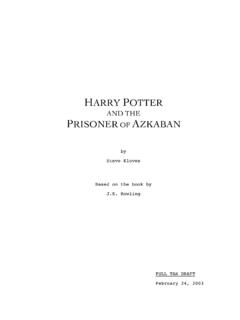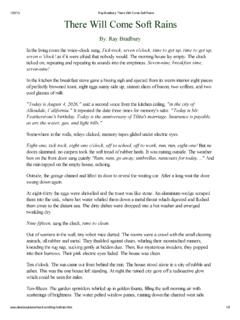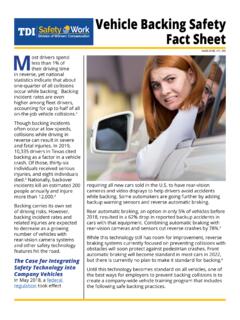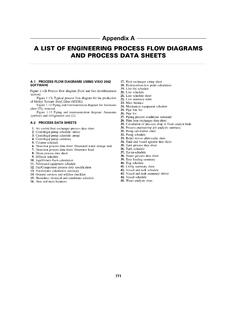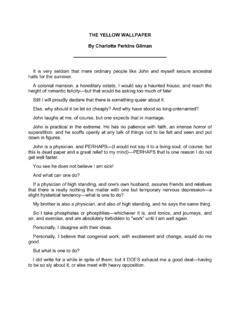Transcription of Environmental Rules for Car Washes
1 TCEQ REGULATORY GUIDANCE Small Business and Environmental Assistance Division RG-434 Revised August 2014 TEXAS COMMISSION ON Environmental QUALITY PO BOX 13087 AUSTIN, TX 78711-3087 The TCEQ is an equal opportunity employer. The agency does not allow discrimination on the basis of race, color, religion, national origin, sex, disability, age, sexual orientation, or veteran status. In compliance with the Americans with Disabilities Act, this document may be requested in alternate formats by contacting the TCEQ at 512-239-0028, fax 512-239-5010, or 800-RELAY-TX (TDD), or by writing PO Box 13087, Austin TX 78711-3087. We authorize you to use or reproduce any original material contained in this publication that is, any material we did not obtain from other sources. Please acknowledge the TCEQ as your source. Printed on recycled paper. Environmental Rules for Car Washes Contents Who should use this guide?
2 1 What Environmental requirements apply to car Washes ? .. 1 Managing Wash Water .. 1 Managing Grit-Trap Waste .. 2 What should I do with my grit-trap waste? .. 2 Who can pump my grit trap? .. 2 What do sludge transporters do with the waste? .. 3 Registering Fuel Tanks .. 3 Authorizing Air Emissions .. 3 How can I reduce the potential for Environmental problems? .. 4 More questions?.. 4 Who should use this guide? This guide summarizes the Environmental requirements for owners and operators of car Washes . It explains the actions you need to take to operate your car wash in compliance with state and federal laws. You should also ask your local Environmental and health authorities about any local requirements. This document is not a substitute for the Rules of the Texas Commission on Environmental Quality or federal laws and regulations. What Environmental requirements apply to car Washes ? Several Environmental Rules apply to car Washes Rules that affect how businesses manage wastes and help protect air and water.
3 In this guide, the Environmental issues for car Washes are separated into four categories: wash water grit-trap waste fuel tanks air emissions Managing Wash Water Car-wash water contains chemicals and sediment that, if released, can contaminate drinking-water supplies, block sewer lines, damage pumps, and upset the proper treatment of wastewater. Operators of self-service car Washes should post signs alerting customers that dumping unwanted (waste) oil and hazardous substances into the drain or on the ground is a crime. Consider installing motion-detector cameras as a defense against illegal dumping, vandalism, and theft. TCEQ regulations require the installation of a reduced-pressure-principle backflow-prevention assembly to protect the incoming water supply from potential contamination hazards. You must have the assembly tested annually by a licensed backflow-prevention-assembly tester; keep a copy of the test and maintenance report form for your records.
4 Install a catch basin or grit trap to filter sediment and trash from the dirty wash water before it enters the sewer system. Consult local plumbing ordinances for any additional requirements on commercial car Washes . Notify the local wastewater treatment plant that you discharge car-wash water into its sewer collection system. Keep a copy of your letter and any response you receive. If you call for authorization to discharge to the collection system, make notes about the conversation. Install a special clean-out access for collecting samples of the wastewater if necessary. Discharging to a septic system is prohibited. Contact the TCEQ Water Quality Permitting team at 512-239-4671 about authorizing an Environmental Rules for Car Washes TCEQ publication RG-434 2 Revised August 2014 alternative discharge option if your car wash cannot connect to a sewer system. One option is to obtain a Level II authorization for the reuse of industrial reclaimed water (30 TAC 210,1 Subchapter E).
5 For details, visit < >. Managing Grit-Trap Waste Grit-trap waste is the solid, liquid, or semisolid material that accumulates in car-wash water. Local plumbing codes and wastewater utilities regulate grit traps. In addition, state Rules detail how you should pump, transport, and dispose of your grit-trap waste. Clean your grit trap regularly to prevent overflows. Do not wait until it is full. A licensed plumber can help with any clogs or problems with the grit trap itself. What should I do with my grit-trap waste? There are three options for managing wet grit-trap waste: drying the wet waste on site drying the wet waste at another site disposing of the wet waste Use an evaporation bed to dry grit-trap waste on site. The TCEQ does not issue construction specifications for drying beds , but their design and maintenance cannot allow a release or cause a nuisance. Registration as a sludge transporter is not required for you to move the wet waste from the grit trap to the on-site drying bed.
6 Only a registered sludge transporter can take wet grit-trap waste off site. The wet grit-trap waste may be dried on another site you own if the site is within 50 miles of your car wash [30 TAC (h)]. If you choose to haul your wet sludge to the drying site yourself, you must register to operate as a sludge transporter by submitting an Application to Register or Renew Registration as a Transporter of Municipal Sludge(s) and Similar Wastes (Form 1 Short for Title 30, Texas Administrative Code, Chapter 210. TCEQ-00481) and the Core Data Form (Form TCEQ-10400). For help understanding the requirements for sludge transporters, see Transporting Sludge Wastes in Texas (TCEQ publication RG-309). Dried grit-trap waste must be removed from the drying site. You may be allowed to put it in the trash or take it to the landfill yourself. Contact the local garbage-collection service or landfill for instructions about proper disposal.
7 A sludge-transporter registration is not required for you to handle the dry grit-trap waste. If you choose not to dry the grit-trap waste, a registered sludge transporter must remove it from your site for proper treatment and disposal. As a waste generator, you should receive a completed copy of the transporter s manifest or trip ticket that documents proper disposal. Keep these records for at least three years. Who can pump my grit trap? Wet grit-trap waste must be removed by a sludge transporter registered with the TCEQ. Transporters are required to keep a copy of their registration in their trucks. Transporters may be registered to pump, remove, or haul more than one type of waste, but they are not allowed to mix types. Costs for this service depend on the frequency and volume of waste pumped, charges for the disposal site, distance to the disposal site, testing requirements, and your choice of a transporter. The frequency of pumping depends on the size of the trap and the amount of waste generated.
8 Rules about sludge transportation are located in 30 TAC 312, Subchapters A and G. For help locating a registered transporter, contact the Registration and Reporting Section at 512-239-6001 or visit < sludgetransporter>. TCEQ publication RG-434 Environmental Rules for Car Washes Revised August 2014 3 What do sludge transporters do with the waste? The grit-trap waste must be disposed of at an authorized landfill, and not all landfills are authorized to accept it. Lab tests may be required. The sediment and chemicals in grit- trap waste make it a special waste [defined in 30 TAC (148)(F)], which requires special handling to protect human health and the environment. Be sure to obtain a copy of the transporter s trip ticket or manifest for your records. The trip ticket must include the following information [30 TAC ]: the name, address, telephone number, and registration number of the transporter the name, signature, address, and telephone number of the person who generated the waste and the date collected the type and amount of waste collected or transported the name and signature of the responsible person collecting, transporting, and depositing the waste the date and place where the waste was deposited identification (permit or site registration number, location, and operator) of the facility where the waste was deposited the name and signature of the facility representative receiving the waste and the amount of waste received the volume of the grit trap To reduce your Environmental impact and the likelihood of compliance violations, keep complete records, verify that the waste was properly disposed of, clean up spills immediately, and reduce the amount of waste you generate.
9 Registering Fuel Tanks If you have a gas pump, Rules apply to your petroleum storage tank. Obtain required registrations related to any PSTs at your site. All PSTs must be constructed and maintained to prevent spills. All releases must be reported and cleaned up immediately. There may also be local restrictions, so check with city and county officials as well as your local fire marshal. Any underground storage tank at a car wash containing fuel or hazardous substances must be registered using the Underground Storage Tank Registration and Self-Certification Form (TCEQ-00724). The annual registration is required for each UST even for those that are empty or unused and requires owners to meet specific financial assurance (for example, insurance) and minimum technical standards (corrosion protection, release detection, and spill and overfill prevention and control [per 30 TAC 334]). Any aboveground storage tank with a capacity greater than 1,100 gallons and containing fuel or hazardous substances is regulated and must be registered using the Aboveground Storage Tank Registration Form (TCEQ-00659).
10 Additional information to help you determine if your tank is regulated is available in Who Regulates Petroleum Storage Tanks? (RG-475k). For help with the registration process, you may contact the TCEQ s PST Registration team at 512-239-2160. For information about other issues, such as installing or removing tanks, contact the PST technical standards team at 512-239-2182. Authorizing Air Emissions Any activity that releases contaminants into the air may require an authorization from the TCEQ. If you operate a typical car wash, then you may meet the requirements of the De Minimis Rule (30 TAC ), which means there is no significant contamination of the air and no other state air authorization will be required. If you dispense gasoline, use solvents, or repair automobiles, additional Rules apply because of the potential to emit air pollutants. You may claim a permit by rule if you meet all the conditions of that rule and the general requirements of 30 TAC and Some Environmental Rules for Car Washes TCEQ publication RG-434 4 Revised August 2014 PBRs require registration by completing the Registration and Certification for Permits by Rule (Form TCEQ-20182).
